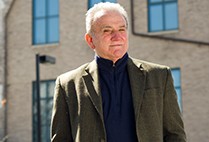
In January 2012, the Boston Globe and Playbill reported that actress Johanna Day had broken her hand during a scripted scuffle in the Huntington Theatre Company production of Yasmina Reza’s God of Carnage.

Although Day was quoted as saying the injury came from slamming into a prop, the online buzz was that she had slapped her costar far too hard.


As a professional fight choreographer, Angie Jepson knew that the story was hogwash. She knew this because in theater, what we see and hear as a slap is rarely a slap at all, but a carefully rehearsed visual trick (in this case directed by a colleague of Jepson’s), and the hand of the slapper and the face of the slapped can be as much as a foot apart.

College of Fine Arts lecturer and fight director Angie Jepson has choreographed everything from frisky intimate encounters to all-out barroom brawls.
THEnotion of stage fights conjures images of Shakespearean jousts or operatic duels, all clanking swords and fancy footwork. But in the three decades since they have become fixtures in professional theater, fight directors like Jepson are called upon to craft melees from playful wrestling to barroom brawls. “There’s an incredible range of things that can fall under the need for a fight choreographer,” says Jepson, a lecturer in the College of Fine Arts School of Theatre, who coached a recent student production of Emily Mann’s Mrs. Packard, the story of a mid–19th-century woman committed to an asylum by her husband. “It can be anything from a fall on the stage to just a slap to full-out brawls to stylized dance fights in a musical.” Jepson has choreographed staged rapes and attempted rapes as well as intimate physical tussling. “We’re often called in to work on scenes like this, to figure out how to make them safe and look believable,” she says. And of course there are the classical sword fights.
Pulling
Punches
with Angie
Jepson
CFA lecturer teaches the fine art of stage combat in the School of Theatre
“It’s safer to go for major muscle groups as opposed to joints. And actors have to know how to make sure there’s enough space for a noncontact move.”
Inspired by an existing organization in England, the Society of American Fight Directors (SAFD) was incorporated in 1977 and has been certifying coaches like Jepson in skills that are essential, but not held in particularly high regard during centuries of theater. SAFD’s first national meeting, in New York City in 1979, was attended by 20 directors; its membership is now nearly 42,000, and stage combat is part of all reputable college acting programs. Actors still occasionally get hurt, but stage combat training is all about safety as well as verisimilitude.
The SAFD breaks stage fighting skills into eight levels, from “actor combatants,” who are proficient in unarmed bouts—the use of arms, fists, and feet—to expertise in knives and swords.
“Small sword is the hardest level, because it’s a very fine weapon requiring lots of precision and control,” says Jepson, one of a half dozen professional fight directors in the Boston area. Actor combatants have solid knowledge of where the safest places are on an opponent to hit or grab, she says. “It’s safer to go for major muscle groups as opposed to joints. And actors have to know how to make sure there’s enough space for a noncontact move, though to the audience it appears contact is made.”
1
How to Stage a Noncontact Slap
During the slap, the actor must time her reaction to when the slapper’s hand crosses in front of her face. Her head must be between the slapper’s hand and the audience, obscuring the moment of “contact.”
2
At that moment, the actor slaps her own thigh with her hand.
3
The actor grunts or shouts in pain convincingly.
“We never really do punch a face on stage. That would be unsafe, and actors like to keep their faces intact.”
To someone positioned at the back of the stage instead of in the audience, choreographed unarmed fights look silly. “We never really do punch a face on stage,” says Jepson, who also teaches stage combat for the CFA Opera Institute. “That would be unsafe, and actors like to keep their faces intact.” And despite how real they look and sound to the audience, stage weapons are different from the real thing and must be specially designed. “A safe stage combat weapon is made of steel, but with a blunted edge,” she says. “Sometimes these weapons have to be even stronger than the real thing.” When actors sustain stab wounds—as was the case in 2008, when British actor Daniel Hoevels slit his own throat with a knife (he survived) in the final scene of Friedrich Schiller’s Mary Stuart—it’s usually because props are switched unintentionally, notwithstanding Murder, She Wrote–style rumors of lethal mischief by jealous rivals. “It’s astounding how often these mix-ups happen,” Jepson says.
Jepson’s most memorable job was directing a brawl in the punk rock musical Bloody Bloody Andrew Jackson. “There were 15 to 20 actors breaking bottles, throwing chairs, slamming into the piano,” she says. “It was by far my favorite fight, and definitely the craziest.”
Jepson herself has done only one fight scene on stage. She was in college, and it was her first professional production, in the play Sueño by José Rivera. Scorned by a lover, Jepson’s character challenged him to a sword fight. No one was hurt.

Punches1
In Jepson's class, students learn the art of convincing but benign stage fights.

Punches2
In theater, what we hear as a slap is rarely a slap at all.

Punches3
One of the most common aspects of stage fights is the harmless choke hold.

Punches4
A stage fight can be anything from a tussle to an all-out brawl, says Jepson.

Punches5
Stage fighting is all about safety as well as verisimilitude.

Punches6
The fights are carefully blocked; the rest is acting.


























































Related Stories
Pulling Punches with Angie Jepson
CFA fight director makes stage bouts convincing, safe
“The King of All Things Are Possible”
Under Petosa, a conservatory that’s also a theater company
Stage Troupe’s Combat: Not for the Squeamish
How to write and stage a play in just 24 hours (with a little help from your friends)
Post Your Comment